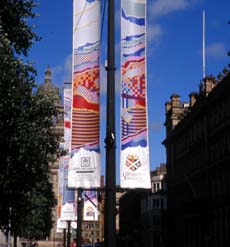index
Boyer on cyber-cities
click on images for full-size:




Street banners, Glasgow

Street scene in Miami Beach

London from the Thames
Since I speak of virtual reality as providing real functioning places. I need to comment on M. Christine Boyer's negative evaluations in CyberCities (Boyer 1996). She is less concerned with virtual reality as such than with its bad effects on a society she sees as beginning to model its physical places and ways of living on the pace and style of virtual realities (which in turn are influenced by the current style of advertising and consumerism). Boyer attacks something I also want to attack, namely the transformation of complex identities into simplified serial intensities. She emphasizes the general substitutability of one such simplified item or place for another in "a combinatorial play of discrete bits and pieces that can be randomly selected, combined, replayed, and rerun." (174) She sees our cities as becoming like "the audio-visual jumps and leaps that are achieved by viewers of cable television when, remote control in hand, they flip through an array of television programs to experience disparate blank spaces, arbitrary sound bites, and fragmented images that never coalesce into a single knowable order." (15) This serialization is one of my targets as well. But while for me this means we should be perceiving new kinds of unity, Boyer worries about the loss of classic patterns. "We can no longer read the city as a totality: it is heterogeneous, fragmented, dismembered, decentered . . . . The city no longer evokes our involvement; it has become numbed, speechless, without a story to tell. We are unable to develop architectural forms that are engaged politically with the urban environment." (119). "Architecture has been reduced to a prosaic background prop, and the command over space that it once might have achieved has disappeared behind the nostalgic dream of a garden paradise" (155).